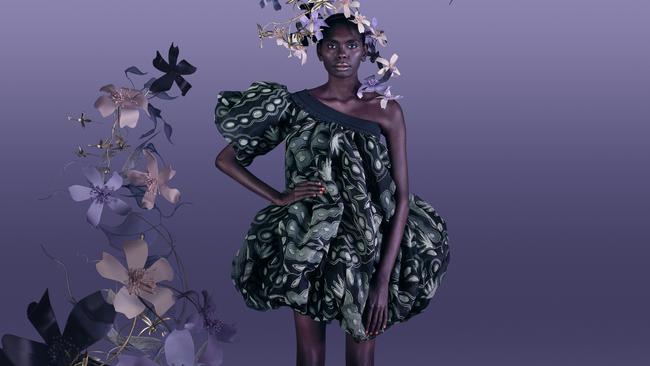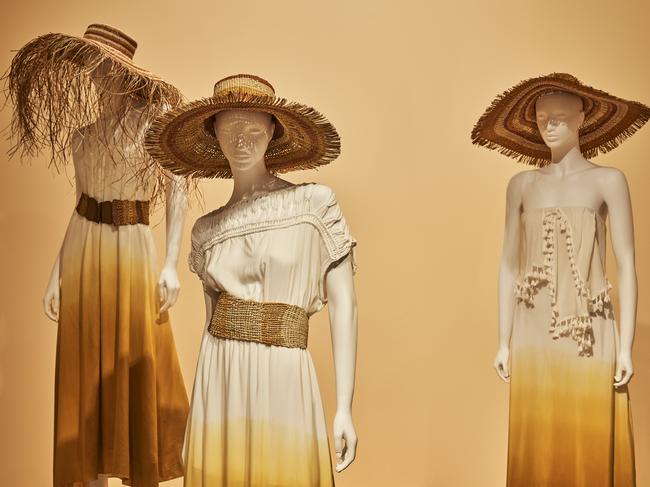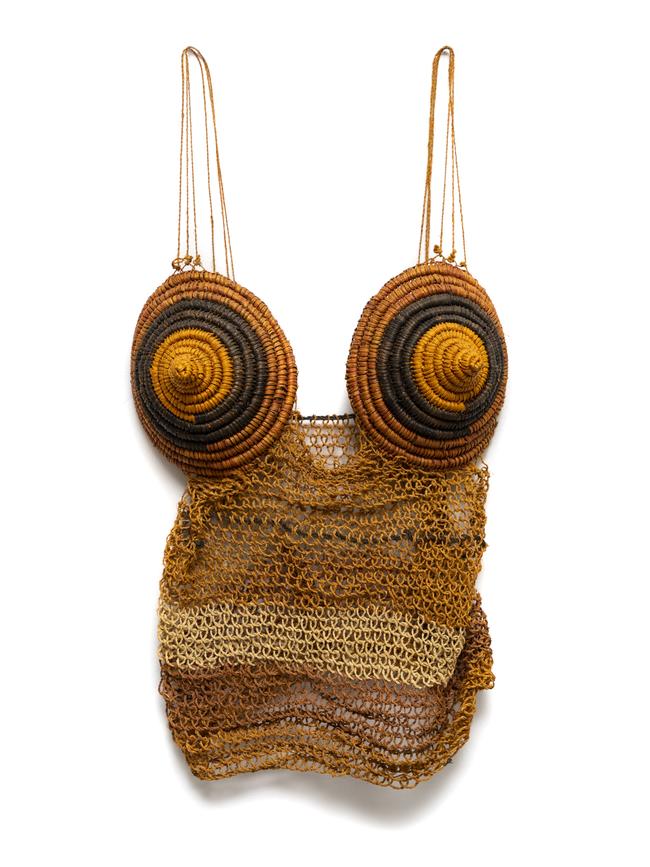Bendigo Art Gallery opens first Indigenous fashion exhibition
The first Australian exhibition of Indigenous fashion is now on show at Bendigo Art Gallery.

While 2020 has not been known for its positives, one anomaly has at last been put right: the first-ever Australian exhibition of Indigenous fashion has just opened at Bendigo Art Gallery in Victoria.
Having suffered a number of postponements due to Covid-19 lockdowns, Piinpi: Contemporary Indigenous Fashion has finally opened its doors to the public.
For the gallery’s First Nations curator, Shonae Hobson, a Southern Kaantju woman from Coen, Cape York Peninsula, the exhibition has been a labour of love that will hopefully mark the beginning of institutional recognition for Indigenous fashion.
“The exhibition seems timely and well overdue,” Hobson tells The Australian.
Hobson conceived of the exhibition two years ago, inspired by the curated fashion performances she had seen at both the Cairns Indigenous Art Fair and Darwin Aboriginal Art Fair in recent years.
Given Bendigo Art Gallery has become known for its innovative and globally inspired fashion exhibitions, including last year’s Balenciaga: Shaping Fashion and 2016’s Maticevski: Dark Wonderland, Hobson felt there was an opportunity to lead the way.

“It’s crazy that anyone hasn’t done a major exhibition on indigenous fashion. To be the first to do it on this scale is quite remarkable.
“Thinking about Australian fashion historically, in the 70s you had Linda (Jackson) and Jenny Kee and collaborations with Indigenous artists and that push for Australiana imagery, but nowhere was there representation of indigenous artists and fashion designers as part of the narrative.”
Seasonal scenes
In the language of Kanichi Thampanyu, the First Nations people of the East Cape York Peninsula, piinpi is an expression used to describe changes in the landscape across the seasons.
The concept lays the framework for the exhibition, which is divided for the most part into four seasonally inspired sections: Dry Season, Wet Season, Cool Season and Regeneration.
It was a way to curate the vast array of over 70 designers, artists and makers from the cities to the most remote areas of the country, working across a variety of media and styles.
“It was important to tie the whole narrative together in concept, to be able to tell stories in a way that speaks to that as opposed to chronologically or (by) artists or region. And it does speak to the overarching stories embedded in the garments - bush foods, landscape and country. For Indigenous people, knowledge of the land and seasons is important.”
Opening the exhibition is a room of four commissioned works by Lyn-Al Young, the Gunnai, Gunditjmara, Yorta Yorta and Waradjuri artist who has in the past two years made a name with her delicate painted-silk work. The pieces are also inspired by the Indigenous seasons that feature in the exhibition.

From here, visitors will walk through an immersive environment that speaks to those seasons, with video installations and soundscapes that include language and sounds of nature.
Visitors will hear sounds including birdsong, “the rustling of the wind and fire from the dry season”, said Hobson.
“(Through) curation and exhibition design we want to get people to immerse themselves in the landscape as if they’re on country and visiting the places the artists come from.”
Those locations include remote art centres that support local artists and communities, such as Mornington Island Artists, Injalak Arts Centre in West Arnhem Land, Northern Territory, Babbarra Women’s Centre in north-central Arnhem Land, and Waringarri Aboriginal Arts in Kununurra, Western Australia. From there, they move to the streets and suburbs of Melbourne, Sydney and more.
Cross pollination
The diversity of pieces and approaches is a true representation of Indigenous fashion as it exists today – embracing both traditional arts and crafts, and reflecting the experiences of Indigenous people in society today.
Other commissions for the show include a possum-skin coat from Rodney Carter, a descendant of the Dja Dja Wurrung and Yorta Yorta people, now a Bendigo local; and three colourful and contemporary printed pieces from Shannon Brett, a Wakka Wakka, Butchulla and Gurang Gurang designer based in Brisbane.

Grace Lillian Lee’s pieces are a striking example of the cross-pollination of the traditional and modern. A descendent of the Meriam Mir people of the Eastern Islands of the Torres Strait, she was taught traditional palm-weaving techniques by the artist Uncle Ken Thaiday on a visit there, only after she graduated from the fashion design course at Melbourne’s RMIT.
Her body sculptures, extraordinarily complex designs worn over the torso, use those techniques but are rendered in colourful cotton webbing and decorated with feathers.
Hobson describes Lee as “a pioneer” in the Indigenous fashion space, thanks not only to her practice, but also her additional work with CIAF and more recently as founder of the First Nations Fashion Design platform, which aims to raise the profile of Indigenous artists and designers across Australia. Hobson believes that her woven body sculptures are “very significant”.
Another woven piece, by Elcho Island artist Margaret Rarru, is a witty take on the iconic Jean Paul Gaultier conical bra made famous by Madonna circa 1990; here, the item is reimagined in natural hues, made from pandanus and kurrajong.
Grace Rosendale is a senior Elder of the Binthi Warra clan, and was part of a collaboration between artists from Hopevale Arts and Cultural Centre in Far North Queensland and students from the Queensland University of Technology. The resulting Seedpods dress is just one of a number of items from the collaboration and brings together Rosendale’s traditional fabric print designs with a buoyant 80s-inspired silhouette.

Some of the winners from the inaugural National Indigenous Fashion Awards, held in August as part of DAAF, are also included in the exhibition. These include Peggy Griffiths’ Legacy dress (since acquired by the gallery), a tiered maxidress that was a collaboration with her daughter and granddaughters out of Waringarri Arts, featuring hand block prints of the traditional jilinybeng (bush cucumber) on the different layers.
A number of pieces from Maara Collective, by Yuwaalaraay designer Julie Shaw, are featured. Her resort-style pieces are simple in cut and feature details such as knotting and fringing, while the woven accessories were a collaboration with three Yolngu master weavers from the Bula’bula Art Centre in Northeast Arnhem Land, Mary Dhapalany, Evonne Munuyngu and Margaret Malibirr.
In contrast to these, Teagan Cowlishaw’s Deadly Kween jumpsuit features in the final section of the exhibition, Blak and Deadly, which focuses on street-inspired fashion. The upcycled design features the word Deadly on the back – cut from a faulty T-shirt.

“It’s about embracing Aboriginal culture,” says Hobson. “(The jumpsuit) really pays homage to the idea of black empowerment through fashion.”
Hobson says that while the show has great diversity in the types of work and collaborations taking place, “for me the most important thing is that the audience embraces Indigenous culture and fashion”.
A number of the works featured in the exhibition have been acquired by the gallery, and will form the kernel of its Australian Fashion Collection.
Following its run at Bendigo, finishing on January 17, the exhibition will open at the National Museum of Australia in Canberra on February 18 and run until August 8.

To join the conversation, please log in. Don't have an account? Register
Join the conversation, you are commenting as Logout